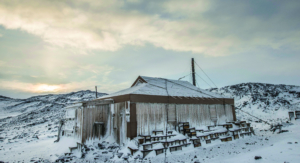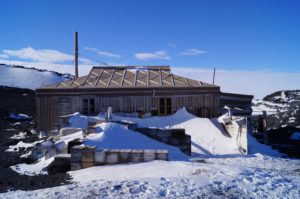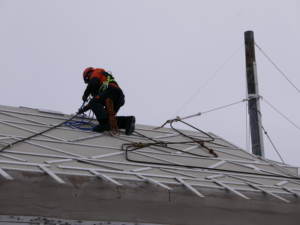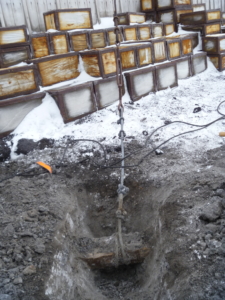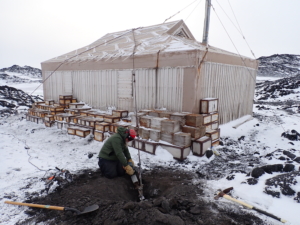Frozen Rigging, Antarctica Bound
Sir Ernest Shackleton didn’t know precisely where he would build his 1908 expedition base in Antarctica, so brought a prefabricated timber building with foundations that could be modified. Cape Royds, where his base ended up, is a mix of ancient lava flows and volcanic gravels. Not level, and with a frozen permafrost layer close to the surface. Other than the shallow piles connecting the building to the ground the main thing that stops the building being blown away in a fierce storm is its own weight, and two 18mm marine hawser cables which criss-cross over the building. Thought to be marine cable used when the Koonya towed the Nimrod partway on the voyage south from New Zealand, the cable is twisted stranded steel wire around a jute fibre core.
Shackleton’s Hut at Cape Royds. © AHT/Alasdair Turner
Shackleton’s Hut at Cape Royds. © AHT/ Lizzie Meek
Last year, AHT discovered that a section of this cable had corroded through after more than 100 years, making the cable unfit for purpose. An emergency repair was made, and this season our team’s most critical on-ice task was to replace both sections of cable.
Sourcing original materials can be a lengthy and frustrating task. After searching worldwide search to find a replacement with the same diameter, number of strands, and inner core as the original marine towing cable, we were finally connected with a Canadian company Northwest Wire Rope Limited who, with incredible generosity, donated the cabling to us. Meanwhile, Covid-19 lockdowns were causing havoc with the freight industry. A little outside the box thinking by our admin star KC found a company with space in a container for our pallet of precious wire cable, so our thanks also go to shipping company Extreme Global, for providing discounted freight services.
Fast forward a few weeks and here’s our team, at Cape Royds on Ross Island, battling -35°C (with windchill) temperatures, ground frozen solid, and needing a heavy duty concrete breaker to dig down to the original ground anchors, called dead men. We speculated over a much needed hot drink at break time whether Shackleton and his team used pick axes or dynamite, although it is possible the ground was unfrozen at the time of year they constructed the hut. It took three days of bone-shaking work for Al, assisted by our rigging expert Ange, and Scott Base Carpenter Mike, to excavate the ground anchors, remove and replace the cable, and to rebury the dead men. We’ve kept the original historic cable at the site, and the hut is now braced for the next 100 years of Antarctic storms.
Replacing the rigging on Shackleton’s Hut at Cape Royds this season. © AHT/Lizzie Meek
© AHT/Al Fastier
© Antarctica New Zealand/Angela Buunk

